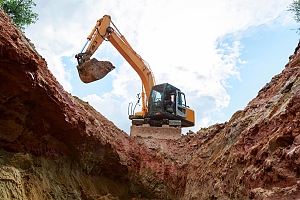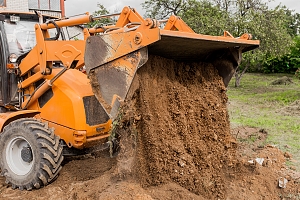When it comes to landscaping, gardening, or any outdoor project involving soil, understanding the concept of a “yard of dirt” is essential. Whether you’re filling a raised bed, leveling a lawn, or starting a construction project, knowing how much a yard of dirt costs and how much ground it covers will help you plan and budget effectively. In this guide, we’ll unravel the mystery behind the yard of fill dirt and explore the factors that influence its pricing and quantity.
Defining a Yard of Dirt
 A yard of dirt, often referred to as a cubic yard, is a unit of volume that measures 3 feet by 3 feet by 3 feet. In simpler terms, it’s a cube with each side measuring one yard. This standardized unit provides a convenient way to quantify and purchase soil for various projects.
A yard of dirt, often referred to as a cubic yard, is a unit of volume that measures 3 feet by 3 feet by 3 feet. In simpler terms, it’s a cube with each side measuring one yard. This standardized unit provides a convenient way to quantify and purchase soil for various projects.
Calculating Yardage for Your Project
Before delving into costs, it’s crucial to understand how to calculate the yardage needed for your specific project. As mentioned in the previous blog, measure the length, width, and depth of the area you plan to fill. The formula Length x Width x Depth will give you the volume in cubic feet, and dividing that by 27 converts it to cubic yards.
Factors Influencing the Cost of a Yard of Dirt
The cost of a yard of dirt can vary based on several factors:
Type of Soil: Different soil types, such as topsoil, garden soil, or fill dirt, come with varying price tags. The quality and nutrient content of the soil can influence the cost.
Delivery Charges: If you’re purchasing soil from a supplier, delivery charges may apply. The distance from the supplier, the quantity ordered, and the delivery method can impact these costs.
Bulk vs. Bagged: Purchasing soil in bulk is generally more cost-effective than buying it in bags. However, if you have a small project or limited storage space, bagged soil might be a more convenient option.
Seasonal Variations: Prices can fluctuate based on seasonal demand and availability. Be aware of any price variations that might occur during peak gardening or construction seasons.
Average Cost Estimates
When planning landscaping or gardening projects, having a clear understanding of average cost estimates is crucial for budgeting purposes. While prices can be influenced by factors such as location, supplier, and the specific type of soil needed, a general guideline can help you anticipate expenses.
For topsoil or garden soil, you can expect to invest approximately $20 to $50 per yard. This range reflects the diversity in soil quality, composition, and nutrient content. Higher-quality topsoil, enriched with organic matter and essential nutrients, tends to be on the higher end of the spectrum, providing optimal conditions for plant growth.
If budget constraints are a consideration, fill dirt offers a more economical alternative. Prices for fill dirt typically fall in the range of $5 to $20 per yard. While it may lack the nutrient richness of topsoil, fill dirt is suitable for certain landscaping needs such as leveling uneven terrain or filling large excavated areas.
To ensure accurate pricing tailored to your specific requirements, obtaining quotes from local suppliers is essential. Local factors, including transportation costs and the availability of soil types, can significantly impact the overall expense. Additionally, consulting with suppliers allows you to discuss your project in detail, ensuring that the recommended soil type aligns with your landscaping goals.
Keep in mind that these estimates serve as general guidelines, and prices can fluctuate based on market conditions and seasonal variations. By investing time in researching and obtaining quotes, you can make informed decisions that not only meet your budgetary constraints but also contribute to the success of your landscaping endeavors.
Budgeting Tips
 Creating and adhering to a budget is essential when undertaking landscaping or gardening projects, and the following tips can help you manage your expenses effectively:
Creating and adhering to a budget is essential when undertaking landscaping or gardening projects, and the following tips can help you manage your expenses effectively:
Compare Prices
Take the time to gather quotes from multiple suppliers in your area. Prices can vary, and different suppliers may offer varying soil qualities or additional services. By comparing prices, you can identify the most cost-effective option without compromising on the quality of the soil.
Bulk Discounts
Many suppliers provide discounts for larger quantities of soil. If your project requires a substantial amount of soil, inquire about bulk pricing options. Purchasing in bulk not only helps you secure a better price per yard but also reduces the need for multiple transactions, streamlining the purchasing process.
DIY vs. Delivery
Assess whether transporting the soil yourself is a viable option. While self-transportation can save on delivery costs, it’s crucial to weigh this against the time, effort, and resources required. Consider the distance to the supplier, the size of your project, and the equipment or vehicle needed. In some cases, the convenience of having the soil delivered directly to your site may outweigh the cost savings associated with a DIY approach.
Seasonal Considerations
Prices for soil can fluctuate seasonally. Understanding these variations can help you plan your project to take advantage of potential cost savings. Some suppliers may offer discounts during slower seasons, so timing your purchases strategically can contribute to significant budgetary benefits.
Payment Terms and Financing
Inquire about the payment terms offered by suppliers. Some may provide financing options or flexible payment plans. Exploring these possibilities can help you better manage your cash flow and spread out the financial impact of your landscaping project.
Local Alternatives
Investigate whether there are local sources for soil, such as landscaping or excavation companies. Local suppliers may offer competitive prices and may have a better understanding of the soil characteristics in your area, ensuring a more tailored solution for your project.
Plan for Contingencies
Build a buffer into your budget to account for unexpected expenses or changes in project scope. This contingency fund can provide financial flexibility and peace of mind in case adjustments are needed during the course of your landscaping project.
By incorporating these budgeting tips into your planning process, you can navigate the complexities of soil procurement with confidence, ensuring that your landscaping project is not only successful but also financially sustainable.
Order High Quality Fill Dirt From Northern Virginia Dirt Experts
Understanding how much a yard of dirt costs and covers is crucial for the success of your outdoor project. By calculating the yardage needed, considering the factors influencing soil pricing, and implementing budgeting tips, you can make informed decisions that align with your project goals and financial plan.
Revitalize your construction project or landscaping venture with the finest fill dirt from Northern Virginia’s trusted experts. Elevate your foundation, enhance your landscape, and ensure the success of your endeavors by ordering high-quality fill dirt from Dirt Connections.
Our team of professionals is dedicated to providing you with top-notch service and premium fill dirt that meets the unique demands of your project. Don’t settle for anything less than excellence – place your order today and experience the difference of working with the premier dirt experts in Northern Virginia. Transform your vision into reality with Dirt Connections – your reliable partner for superior fill dirt solutions


